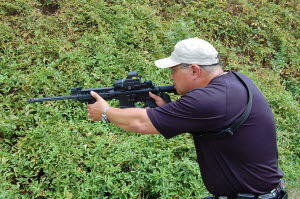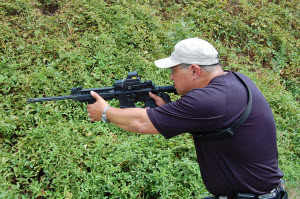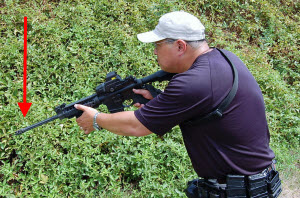
A ready position is a position in which the firearm is in hand and you are expecting trouble, moving through a conflicted area, or see the need to be prepared due to situational circumstances. The firearm should be in some type of ready position when not being stored safely, the handgun is out of the holster, or the long gun is off the sling. The firearm is placed such that it can be utilized for a variety of situations:1. Contact/Challenge Ready: This is a position in which the firearm is on target or slightly depressed off target and, due to the situational dynamics, a verbal challenge is issued. The circumstances of the situation do not justify engaging the target at the immediate moment, but the firearm can be brought on target and fired rapidly, if justified. 2. Movement Ready: In one of these positions, the firearm is pointed in a safe direction, which helps facilitate safe and tactical navigation and movement through a specific environment. Travel tempo and environmental factors such as proximity to non-threats, elevated structures (balconies), stairwells or environmental obstacles determine which Movement Ready position to utilize. 3. Depressed Ready: No immediate threat is identified, yet there is a need to keep the firearm at hand and in a ready position. This may be the case with a law enforcement officer standing perimeter at a crime scene or a citizen standing ready and prepared to defend property or people during a natural disaster such as Hurricane Katrina.Generally speaking, when assuming a ready position, the firearm is between you and the potential threat, giving you the ability to visualize the threat’s hands. The most common firearm ready positions taught today fall into one or more of the above categories. When utilizing most firearm ready positions, the fundamental concept of head up, eyes up and gun up should be followed.For the purposes of this article, I will outline three common firearm ready positions applicable to citizen personal protection and firearm readiness: Close Ready, Modified Low Ready and Depressed/Indoor Ready. It is important to note that from school to school, organization to organization, or instructor to instructor, the names of various ready positions may vary.Close Ready Position: High and close to visual plane, finger off trigger.
Close Ready
Close Ready is a pistol ready position that places the handgun just below the visual plane and close to the torso. The elbows are down and tight to the sides of the torso, and the muzzle can be seen with the lower periphery of vision. Close Ready can be utilized as a Movement Ready position to traverse space and is especially good when working in structures. Close Ready may also be utilized as a Challenge position. Keeping the gun high and close to the visual plane allows rapid extension and sight acquisition.
Proper utilization of the Close Ready position eliminates excessive muzzle over-sway or swing past the intended target while under stress or when transitioning from one target to another. A one-pound handgun held with only two points of contact extended at arm’s length often facilitates this over-sway and is frequently seen from both new and experienced shooters when shooting from a traditional low ready position with the handgun. This over-sway is not as common with long guns because four points of contact can be made with the firearm. This provides better overall control of momentum when moving from a designated ready position onto target.

Modified Low Ready Position: Muzzle depressed enough to visualize threat’s hands, finger off trigger.
Modified Low Ready
In the Modified Low Ready position, the muzzle of the firearm is depressed only enough so the operator can visualize the threat’s hands. The degree to which the muzzle is depressed off target is dependent upon the distance from the threat. At five yards, the muzzle may be depressed to almost a 45-degree angle in order to provide a good visual of the threat’s hands. However, at 15 yards, the muzzle may appear to a third-party observer to be right on target.
Depressed/Indoor Ready
Depressed or Indoor Ready places the firearm with the muzzle approximately 20 degrees off the toes of the support-side foot, with the toe of the long gun’s stock maintaining contact with the shoulder in preparation to mount rapidly. With a handgun, this position is often referred to as “Sul” or South, a term coined by Max Joseph of Tactical Firearms Training Team. Depressed Ready is a stand ready position and is also utilized for moving in and around other people or teammates in crowded areas or confined spaces. Since the firearm is some distance from the visual plane and sight acquisition is slower, maintaining awareness when in this ready position is essential.
Conclusion
Not just for the range, firearm ready positions are applicable to real-life situations and can help reduce reaction time during critical incidents. Firearm ready positions provide efficient means for employing the firearm when it is required. This efficiency can equal the fraction of a second you need either to act first or react to an imminent threat.


[…] This technique is very fast and more than combat accurate at the five- to ten-yard line. This drill was repeated several times while increasing rounds fired from two up to six. This combat focus drill is a trademark drill of PDN and Pincus. If you’re not familiar with the Sul or indoor ready position as it is sometimes called, take a look at this. […]
Thank you, SAF, for what you do. Frank Hinson, GRNC Board